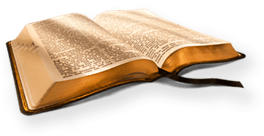King James Bible
King James Version (KJV)


"Is employed in the English Bible to denote military equipment," both offensive and defensive. "(1.) The offensive weapons were different at different periods "of history. The "rod of iron" (Ps. 2:9) is supposed to mean a" "mace or crowbar, an instrument of great power when used by a" "strong arm. The "maul" (Prov. 25:18; cognate Hebrew word" "rendered "battle-axe" in Jer. 51:20, and "slaughter weapon" in" "Ezek. 9:2) was a war-hammer or martel. The "sword" is the usual" "translation of hereb, which properly means "poniard." The real" "sword, as well as the dirk-sword (which was always" "double-edged), was also used (1 Sam. 17:39; 2 Sam. 20:8; 1 Kings" 20:11). The spear was another offensive weapon (Josh. 8:18; 1 "Sam. 17:7). The javelin was used by light troops (Num. 25:7, 8;" "1 Sam. 13:22). Saul threw a javelin at David (1 Sam. 19:9, 10)," "and so virtually absolved him from his allegiance. The bow was," "however, the chief weapon of offence. The arrows were carried in" "a quiver, the bow being always unbent till the moment of action" (Gen. 27:3; 48:22; Ps. 18:34). The sling was a favourite weapon of the Benjamites (1 Sam. 17:40; 1 Chr. 12:2. Comp. 1 Sam. 25:29). "(2.) Of the defensive armour a chief place is assigned to the shield or buckler. There were the great shield or target (the "tzinnah), for the protection of the whole person (Gen. 15:1; Ps." "47:9; 1 Sam. 17:7; Prov. 30:5), and the buckler (Heb. mageen) or" "small shield (1 Kings 10:17; Ezek. 26:8). In Ps. 91:4 "buckler" is properly a roundel appropriated to archers or slingers. The "helmet (Ezek. 27:10; 1 Sam. 17:38), a covering for the head; the" "coat of mail or corselet (1 Sam. 17:5), or habergeon (Neh." "4;16), harness or breat-plate (Rev. 9:9), for the covering of" the back and breast and both upper arms (Isa. 59:17; Eph. 6:14). "The cuirass and corselet, composed of leather or quilted cloth," "were also for the covering of the body. Greaves, for the" "covering of the legs, were worn in the time of David (1 Sam." 17:6). Reference is made by Paul (Eph. 6:14-17) to the panoply "of a Roman soldier. The shield here is the thureon, a door-like" "oblong shield above all, i.e., covering the whole person, not" "the small round shield. There is no armour for the back, but" only for the front. An officer selected by kings and generals because of his "bravery, not only to bear their armour, but also to stand by" them in the time of danger. They were the adjutants of our modern armies (Judg. 9:54; 1 Sam. 14:7; 16:21; 31:6). The place in which armour was deposited when not used (Neh. 3:19; Jer. 50:25). At first each man of the Hebrews had his own "arms, because all went to war. There were no arsenals or" "magazines for arms till the time of David, who had a large" "collection of arms, which he consecrated to the Lord in his" "tabernacle (1 Sa,. 21:9; 2 Sam. 8:7-12; 1 Chr. 26:26, 27)."